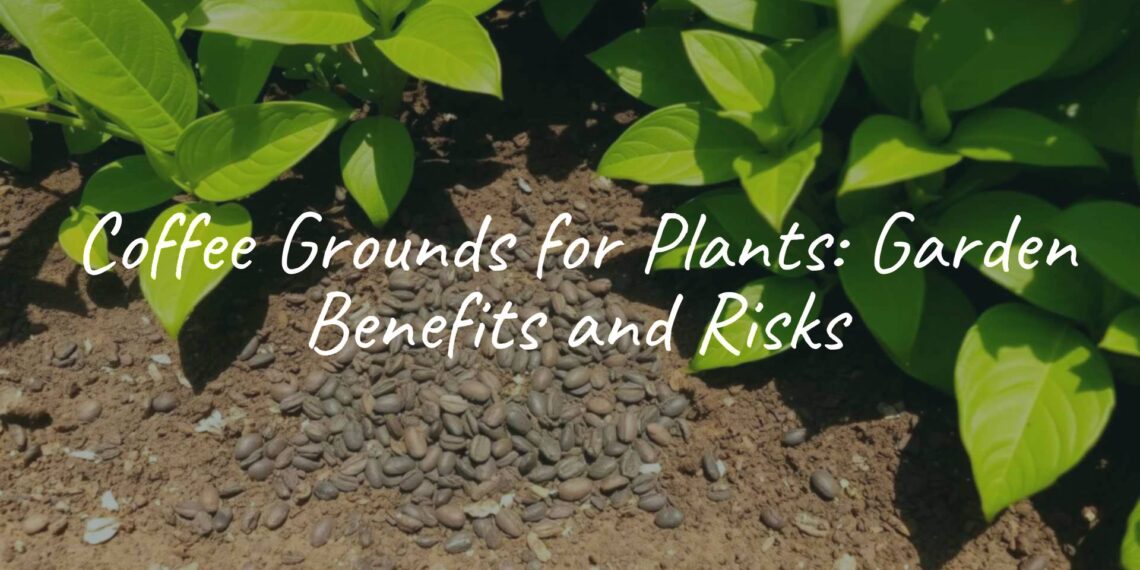Are coffee grounds a gardener’s handy helper or a source of mixed results? The short answer: both. Many people say they improve soil and plant growth, while others warn about problems if used the wrong way. The real story is about how you use them. Used in the right amount and in the right places, coffee grounds can bring many benefits to your soil, garden, and houseplants. But too much or poor use can cause trouble. Learn the basics before you spread what’s left of your morning brew.
This guide explains how coffee grounds work in gardening: what they’re made of, the benefits, the risks, and smart ways to use them. You’ll learn which plants like them and which plants do better without them, so your garden thrives. Grab a cup of coffee, and let’s get started.
What Are Coffee Grounds for Plants?
Using coffee grounds for plants means reusing the grounds left after brewing coffee as a soil add-in or part of compost. It’s an easy way to recycle a common household waste and add organic matter to your garden instead of sending it to the trash. This approach cuts waste and adds useful materials to your beds and pots.
Gardeners have long looked for simple ways to build better soil with natural inputs. Since coffee grounds are easy to get, they quickly became a popular choice. The debate around their use comes from different experiences and views on their chemistry, especially acidity and how nutrients are released.
Why Use Coffee Grounds in Gardening?
There are a few main reasons:
- Waste reduction: Billions of cups are brewed each year. Using the grounds reduces trash. Many coffee shops will give used grounds away for free.
- Low cost: They’re easy to find and don’t cost much or anything at all.
- Soil building: Coffee grounds add organic matter that supports roots and soil life.
Adding organic matter copies what happens in nature, where decaying plant material feeds the soil and keeps gardens healthy over time.
Nutritional Composition of Coffee Grounds
As they break down, coffee grounds release nitrogen, which supports leafy growth. They’re not a strong fertilizer, but they feed slowly over time. Used grounds often contain about 1% to 2% nitrogen by volume.
They also carry small amounts of potassium and phosphorus, plus trace elements that plants need in tiny doses, such as boron, calcium, copper, iron, magnesium, and zinc. These help with processes like photosynthesis and natural defenses.
| Nutrient | What you get from used grounds |
|---|---|
| Nitrogen (N) | About 1-2% (slow release) |
| Phosphorus (P) | Small amount |
| Potassium (K) | Small amount |
| Micronutrients | Boron, calcium, copper, iron, magnesium, zinc (trace) |
How Do Coffee Grounds Benefit Plants?
Used the right way, coffee grounds can support both plants and soil. They offer nutrients, improve structure, feed helpful microbes, and may help reduce weeds and some pests.

Enriches Soil Nutrients
Grounds add nitrogen slowly as they decompose, which supports leaf growth without a sharp spike that can stress plants. With potassium, phosphorus, and small amounts of other elements, they can round out your soil’s nutrition. They won’t replace a full fertilizer plan, but they help build richer soil.
Improves Soil Structure and Water Retention
The coarse texture helps open up compacted soil, letting air reach roots and water drain more easily. At the same time, as grounds break down, they form humus-like materials that help soil hold water. That mix-better drainage plus better moisture holding-can suit plants like hostas, primroses, and bleeding hearts.
Promotes Beneficial Microorganisms
Grounds feed helpful microbes that break down organic matter and release nutrients. These microbes also make sticky compounds that help soil clump into healthy crumbs. Studies show that used grounds can support helpful bacteria and fungi such as Pseudomonas, Fusarium, and Trichoderma, which can help reduce disease pressure from rots and wilts in crops like potatoes, peppers, and eggplants.
Helps Suppress Weeds and Pests
A thin layer of grounds can slow weed growth. Coffee contains compounds, including caffeine, that can reduce seed sprouting and slow the growth of unwanted plants. This can help keep beds tidy without chemical weed killers.
Grounds may also help with some pests. Dry grounds alone have mixed results against slugs and snails, but strong coffee solutions have been shown to kill slugs due to caffeine. The smell can also discourage cats from digging in beds. Burning dried grounds produces a smoky scent that can keep mosquitoes and flies away.
What Are the Risks of Using Coffee Grounds for Plants?
There are downsides if you use too much or use them the wrong way. Keep your use light and smart to avoid problems.
Soil Acidity Issues
Many people think used grounds are very acidic. Brewing pulls out most of the acidity, so used grounds are closer to neutral, often around pH 6.2-6.8. Some sources even list 6.8. That said, heavy, repeated use can nudge soil slightly more acidic over time. Plants that prefer alkaline soil may not like that shift.
Unused grounds and brewed coffee are more acidic. Fresh grounds are quite acidic, and leftover liquid coffee is often near pH 5. These can cause pH problems if used directly on many plants.
Potential for Excess Moisture and Mold
Grounds hold water well. Too much in one spot can lead to soggy soil. Thick, wet layers can dry into a hard crust that sheds water and blocks air. That makes it harder for roots to breathe and take up nutrients.
Wet grounds can also invite mold, especially indoors or in damp, humid areas. Mold looks bad and points to poor growing conditions for roots.
Possible Inhibition of Seedling Growth
Even used grounds contain caffeine and other compounds that can slow seed sprouting and early growth. Seedlings and tender young plants are more sensitive. Putting grounds right around them can stress roots and slow establishment.
Too much around mature plants can also stunt growth and limit root development. While some research links caffeine to stronger disease defenses, high amounts can still slow growth, so go easy near young or sensitive plants.
Harm to Sensitive or Alkaline-Loving Plants
Some plants prefer alkaline soil and don’t handle extra acidity well. Examples include asparagus, beets, geraniums, lavender, rosemary, and spiderwort. Plants that like drier soil, such as cacti and succulents, may also struggle, since grounds can hold more water than they need. Aloe vera, orchids, and pothos are also usually poor matches for coffee grounds.
Which Plants Like Coffee Grounds?
Plants that like slightly acidic soil and steady, gentle nutrition often do well with used grounds.
Acid-Loving Garden Plants
These plants tend to like slightly acidic conditions (pH around 6.2-6.8 for used grounds; fresh grounds are more acidic):
- Rhododendrons and azaleas
- Hydrangeas (can support bluer blooms)
- Gardenias and camellias
- Roses
- Blueberries
Fruits and Vegetables that Benefit
Many fruits and vegetables enjoy a light, steady nitrogen input and slightly acidic soil:
- Carrots, cucumbers, peppers, radishes
- Tomatoes (reports vary; many gardeners see good results)
- Strawberries, pineapples
- Mango, citrus, and avocado trees
- Leafy greens like lettuce and spinach
Houseplants that Respond Well
Some common indoor plants that prefer slightly acidic mixes:
- African violets and gloxinias
- Crotons
- Monsteras, peperomias, and philodendrons
Use very small amounts in pots. You can also use a weak “coffee tea” to water them for more control and less risk of mold.
Which Plants Should Avoid Coffee Grounds?
Certain plants react poorly to the mild acidity or extra moisture.
Plants Sensitive to Acidity
Alkaline-loving plants (higher pH) usually don’t do well with coffee grounds:
- Asparagus, beets
- Geraniums
- Lavender, rosemary
- Spiderwort
Drought-tolerant plants also may struggle with the extra moisture held by grounds:
- Cacti and succulents
- Aloe vera
- Orchids
- Pothos
Seedlings and Young Plants
Keep grounds away from seed trays and new transplants. The compounds in coffee can slow sprouting and stunt young roots. Once plants are well established, small amounts are safer.
How to Prepare and Store Coffee Grounds for Plant Use
Don’t toss wet grounds straight onto beds or pots. A little prep helps avoid mold and crusting.
Best Ways to Dry and Store Used Coffee Grounds
Dry your grounds well before use, especially if you plan to use them directly or as mulch. Wet piles can clump and dry into a crust that repels water. Damp grounds also invite mold.
- Spread used grounds in a thin layer on a tray, baking sheet, or newspaper.
- Air-dry in a sunny or breezy spot until loose and crumbly.
- Store dry grounds in a cool, dry, airtight container.
- If you collect a big bag from a cafe, spread and dry them before storing long term.
Should You Use Fresh or Used Grounds?
In most cases, choose used (brewed) grounds for direct use in the garden. Fresh grounds are more acidic and higher in caffeine, which can stress many plants and mess with soil pH. Used grounds are closer to neutral and gentler. You can add fresh grounds to compost, where they’ll break down and mix safely with other materials, but for direct use or mulch, pick spent, dried grounds.
How to Apply Coffee Grounds to Plants
Method matters. Apply lightly and in ways that fit your plants and soil.

Direct Application Methods
- Sprinkle a thin layer (no more than about 1/8 inch) on top of soil.
- Lightly scratch the top inch of soil to blend the grounds in.
- Keep grounds away from stems to avoid rot.
- For pots, use very small amounts or mix a little into fresh potting soil.
Using Coffee Grounds in Compost
Composting is often the safest way to use a lot of grounds. Treat grounds as a “green” (nitrogen-rich) input.
- Use about 3 parts “browns” (dry leaves, straw, wood chips) to 1 part “greens” (grounds, kitchen scraps).
- Keep coffee grounds to about 20-30% of the pile volume.
- Layer and turn the pile now and then to keep air flowing.
- Unbleached paper filters can go in too.
Making Coffee Ground Mulch
Don’t mulch with pure grounds. Mix them with other materials for a better blend:
- Combine with shredded dry leaves, straw, or grass clippings.
- Blend well so grounds don’t form a crust.
- Spread around plants, keeping mulch a little away from stems.
Brewing Coffee Ground Liquid Fertilizer
For a quick, gentle feed-great for containers and houseplants-make a weak “coffee tea.”
- Add about 2 cups of used grounds to 5 gallons of water (or 1:10 by volume in smaller batches).
- Let it sit overnight, then use the liquid to water plants.
- You can test it as a foliar spray on a few leaves first.
- Use about once a week during the growing season.
Recommended Application Frequency
Go light and steady:
- Direct use or mulch: a thin sprinkle once a month or every few weeks.
- Compost: add regularly, keeping within the 20-30% guideline.
- Liquid feed: about weekly for hungry or potted plants.
Watch your plants. If you see yellowing, slowed growth, or mold, cut back. A soil test every few years can guide pH and nutrient needs.
Common Mistakes and Tips for Success
Using coffee grounds can help or hurt, depending on how you apply them. Avoid these common errors and use a few simple habits to get better results.
How to Avoid Overapplication
Too much is a common problem. Think of grounds as a seasoning, not the main ingredient.
- Direct use: keep layers thin (about 1/8 inch max).
- Compost: cap grounds at 20-30% of total volume.
- Potting mix: about 10 parts soil to 1 part grounds as a rough guide.
- Watch plants for stress and adjust.
Preventing Mold and Fungal Issues
- Dry grounds fully before storage or use.
- Mix grounds into soil or blend with other mulches so air can flow.
- Avoid thick, pure layers of grounds.
- Indoors, use very small amounts or switch to liquid “coffee tea.”
Mixing with Other Soil Amendments
Grounds work best as part of a mix. Combine them with compost and other organic materials.
- In compost: balance greens (grounds) with browns (leaves, straw, chips).
- As mulch: blend with leaves or grass clippings to prevent crusting.
- In beds: pair with finished compost or other balanced amendments for a fuller nutrient range.
Frequently Asked Questions About Coffee Grounds for Plants
Even after all this, some questions come up again and again. Here are quick answers.
Do Coffee Grounds Deter Pests?
Results vary by pest and method. Dry grounds alone are hit-or-miss for slugs and snails. A stronger coffee solution has been shown to kill slugs due to caffeine. The smell also tends to keep cats out of beds. Burning dried grounds can help repel mosquitoes and flies. For other pests, don’t rely on grounds alone; use other controls as needed.
How Often Should I Add Coffee Grounds?
For direct use or mulch, apply a thin layer about once a month or every few weeks in the growing season. Mix in lightly. In compost, add grounds often but keep within the 20-30% total volume range. For liquid feed, weekly works well for many container plants. Watch plant responses and adjust.
Can Coffee Grounds Replace Fertilizer?
No. Grounds add helpful nutrients and organic matter, but they don’t supply everything plants need in the right amounts across the whole season. Use them along with compost and, if needed, a balanced fertilizer. Soil tests can help you decide what else to add.
Do Coffee Grounds Affect Soil pH Long-Term?
Used grounds are close to neutral (around pH 6.2-6.8), so the short-term pH effect is small. Heavy, repeated use can make soil slightly more acidic over time. Don’t rely on coffee grounds to change pH. If you need real pH shifts, use proven methods like elemental sulfur to lower pH or lime to raise it. Many university extensions, including Oregon State University, offer guidance on this.















![What to with Scrap Metal? [infographic]?](https://facts-homes.com/wp-content/uploads/2019/07/645413-POPYOV-391-120x86.jpg)






